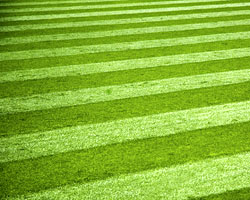YOU ARE HERE Garden Answers > Lawns > Spring lawn care
Spring lawn care
Spring is the time to start a regular programme of lawn care - mowing, feeding and weed and moss control - to ensure you get the best from your lawn all year.
Follow our hints, tips and advice for a better lawn with no problems.
Supplied by Love The Garden
 |
 Days are getting longer, the air is warming up, and green shoots are starting to appear as thoughts turn to the summer to come. There's nothing like long, hot days spent relaxing on a healthy, luscious, cool green lawn. Except what you are looking at in your back garden is nothing like a healthy, luscious, cool green lawn! Bare spots, weeds, moss - it all looks rather pathetic. To make matters worse, your next door neighbour has a sweeping expanse of deep green perfection. But don't despair, like most gardening, lawn care doesn't need to be hard or complicated - nor is it particularly time consuming or costly. Spring is the perfect time to breathe new life into your beleaguered lawn to prepare it for the summer ahead.
Days are getting longer, the air is warming up, and green shoots are starting to appear as thoughts turn to the summer to come. There's nothing like long, hot days spent relaxing on a healthy, luscious, cool green lawn. Except what you are looking at in your back garden is nothing like a healthy, luscious, cool green lawn! Bare spots, weeds, moss - it all looks rather pathetic. To make matters worse, your next door neighbour has a sweeping expanse of deep green perfection. But don't despair, like most gardening, lawn care doesn't need to be hard or complicated - nor is it particularly time consuming or costly. Spring is the perfect time to breathe new life into your beleaguered lawn to prepare it for the summer ahead.
 Moss, weeds and feeding the lawn
Moss, weeds and feeding the lawn
If you have a moss problem then it needs to be tackled first. Fortunately, control is easy - just apply an EverGreen lawn care product that contains a mosskiller.
EverGreen Complete is an ideal solution as it has a unique 4in1 formulation that will tackle moss, control weeds, feed your grass and improve water absorption - all from just one application.
Lawn raking
Having zapped the moss, it's time to give the entire lawn a gentle raking to remove debris. Be careful to not rake your lawn until after you've killed the moss, or you'll just spread spores all over the place.
Next, let's tackle the issue of thatch. Excessive thatch (the layer of dead stems and roots) is a common problem for established lawns. A thick layer of thatch can become a barrier, stopping water and nutrients from reaching the soil. Raking with a wire garden rake, and mowing regularly should be adequate for thatch control.
Aeration is also important to improve drainage and help the grass grow healthily. To aerate, simply push the tines of a garden fork into the soil about 10cm (4in) deep and 15cm (6in) apart. This will allow water and air to reach roots and improve drainage.
Grass type
It's important to consider how much wear and tear your lawn will undergo. If the kids spend all summer using the lawn as a football pitch, then growing fine grass suitable for a bowling green is a bad idea, unless of course you enjoy looking at a big patch of brown dirt!
It's important that the grass mix is right for purpose. If you are in any doubt about what to choose, we'd recommend using EverGreen Multi-Purpose Grass Seed, which contains a quality mix of seed suitable for most hard-wearing lawns.
 Lawn bare patches
Lawn bare patches
Now let's fix those bare patches. Either cut out the bare patch, rake the soil and patch with turf, or, sow new grass seed. EverGreen Lawn Repair Kit is excellent for repairing patches, it has both lawn seed and feed.
Lawn mowing
It's also time to dust off the faithful mower and give the lawn a good cut. Set the mower to cut at a grass length of about 3cm (1.5in). Cutting any shorter at this time of year will open the door to weeds like daisies and dandelions.
From now on, your lawn will need mowing regularly - for a utility lawn once a week is about right, just don't cut it too short.
More information on lawn care in Garden Answers >>
If you want to know more, or if you've got a gardening problem you need help with, then send an e-mail to: info@gardenforumhorticulture.co.uk


